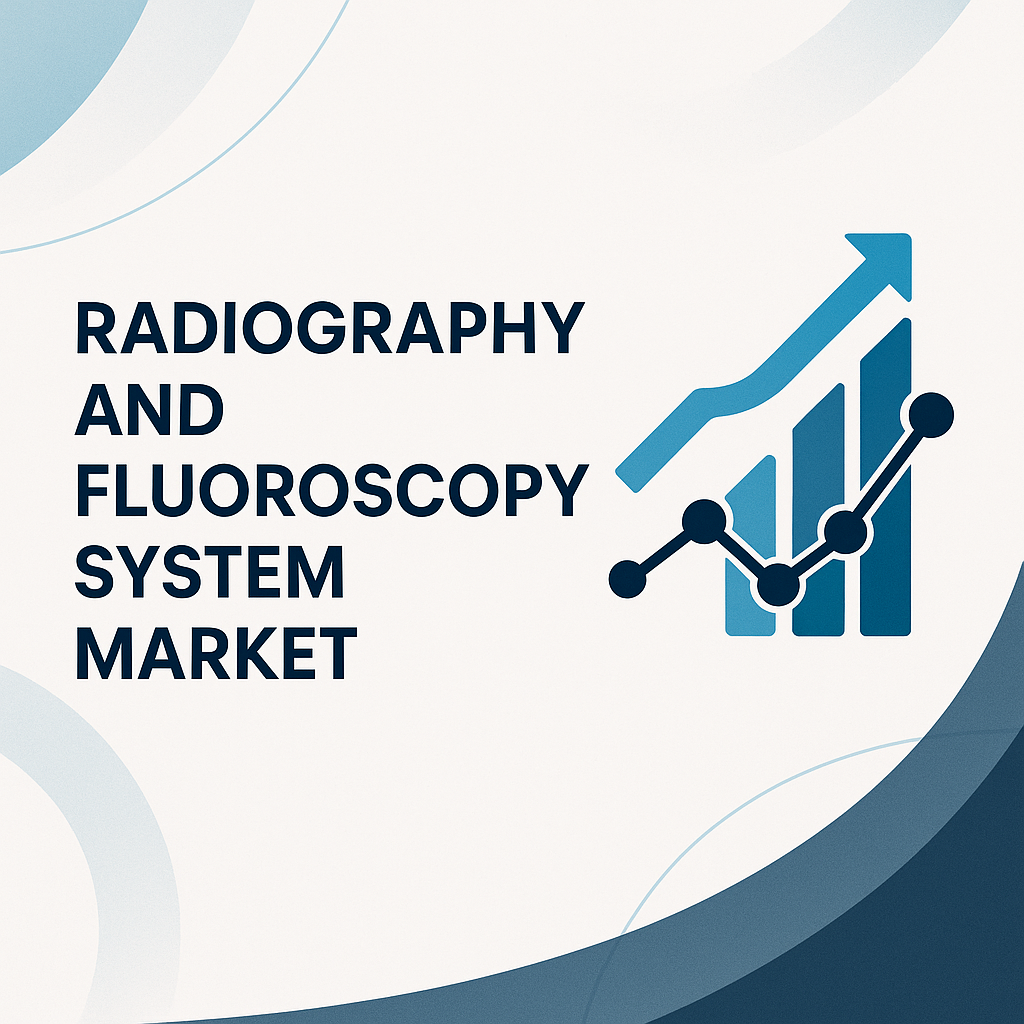Radiography and Fluoroscopy System Market Overview
The global radiography and fluoroscopy system market is undergoing significant transformation, fueled by rapid technological advancements, evolving diagnostic needs, and increased healthcare infrastructure spending. In recent years, the market has shown consistent growth and was valued at approximately USD 5–6 billion in 2024. Projections estimate it will reach nearly USD 8–9 billion by 2032, growing at a compound annual growth rate (CAGR) of 4% to 6% over the next 5–10 years.
Radiography and fluoroscopy are two essential imaging techniques widely used in modern medicine. Radiography is employed for static imaging, such as chest X-rays, bone scans, and mammography, while fluoroscopy provides real-time moving images that are crucial in interventional procedures like catheter insertions, orthopedic surgeries, and gastrointestinal evaluations.
Key Factors Driving Market Growth
-
Rise in Chronic and Age-Related Diseases: Increasing prevalence of cardiovascular, orthopedic, and respiratory diseases—particularly among aging populations—is creating a higher demand for efficient diagnostic tools. Radiography remains a frontline diagnostic technique, while fluoroscopy plays a vital role in treatment planning and surgical guidance.
-
Growth in Minimally Invasive Procedures: There is a strong trend toward image-guided and minimally invasive surgeries, where real-time imaging via fluoroscopy systems is critical. This demand is especially prevalent in cardiology, oncology, and neurology.
-
Technological Advancements: The shift from analog to digital radiography, the development of flat-panel detectors, and advancements in image processing have significantly enhanced diagnostic accuracy. Digital systems offer better image quality, reduced radiation dose, faster workflow, and easier storage and sharing of data through PACS (Picture Archiving and Communication Systems).
-
Expansion of Healthcare Infrastructure: Developing regions are witnessing substantial investments in healthcare infrastructure, leading to higher adoption of advanced imaging systems. Portable and mobile radiography units are also finding wider application in rural healthcare, emergency rooms, and disaster zones.
-
COVID-19 Impact and Legacy: The pandemic highlighted the need for efficient chest imaging to diagnose and monitor lung-related infections. As a result, mobile radiography systems saw increased deployment, and healthcare providers have continued to invest in versatile, high-throughput imaging equipment post-pandemic.
Market Trends and Challenges
One of the prominent trends is the integration of artificial intelligence (AI) in imaging systems, allowing for automated detection of anomalies, enhanced image quality, and workflow efficiency. AI-driven diagnostics and remote access to imaging data are accelerating the transition toward smart radiology solutions.
However, the market also faces challenges such as high initial capital investment, ongoing maintenance costs, and limited technical expertise in some regions. Moreover, concerns over radiation exposure and stringent regulatory requirements can hinder adoption rates, especially in low-resource settings.
Radiography and Fluoroscopy System Market Segmentation
The market can be segmented into four key categories:
1. By Modality
Radiography Systems
Radiography systems are the most widely used imaging tools globally. They capture static, two-dimensional images and are essential for diagnosing bone fractures, lung conditions, infections, and cancers. With the transition from analog to digital radiography (DR), the market has seen increased efficiency and image clarity. DR systems, in particular, offer immediate image preview and lower radiation dose. Computed radiography (CR) serves as an intermediate technology and remains in use in regions with budget constraints. Radiography remains the highest-volume modality, supported by its wide applications across outpatient clinics, hospitals, and diagnostic centers.
Fluoroscopy Systems
Fluoroscopy provides dynamic, real-time imaging, essential during surgical procedures and interventional treatments. It enables visualization of organ motion and contrast flow, making it invaluable for gastrointestinal, urological, and cardiovascular imaging. The system has evolved from image intensifiers to flat-panel detectors (FPDs), which improve image resolution and reduce patient radiation exposure. Though fluoroscopy systems have lower sales volumes compared to radiography, they generate higher value due to their advanced functionality and integration with other systems like C-arms and surgical suites.
2. By Technology
Analog Imaging Systems
Analog systems are still found in developing markets and smaller healthcare facilities due to their lower cost. These systems use film-based technology to produce images, often requiring chemical processing and physical storage. Although they offer lower operational costs initially, they are less efficient, produce lower image quality, and involve higher long-term costs related to consumables and storage. Market share for analog systems is steadily declining due to the global push for digital transformation.
Digital Imaging Systems
Digital radiography and fluoroscopy systems dominate the modern market due to their speed, efficiency, and diagnostic precision. Flat-panel detectors, digital storage, and image enhancement tools make these systems highly desirable. Direct digital radiography systems transmit images instantly to viewing stations or cloud storage, allowing for quicker diagnoses and enhanced patient throughput. As healthcare providers aim to reduce turnaround times and radiation doses, digital systems are expected to hold a majority market share. The digital trend is further accelerated by AI-enabled platforms that assist in image interpretation.
3. By Mobility
Stationary Systems
These systems are installed permanently in diagnostic rooms and are best suited for high-volume imaging departments. They offer greater stability, higher power output, and can accommodate a wide range of exams. Stationary radiography and fluoroscopy systems are preferred in large hospitals, academic institutions, and specialty clinics. They offer advanced features such as auto-positioning, dual detectors, and integration with hospital information systems.
Mobile and Portable Systems
Mobile systems are gaining popularity due to their flexibility and ability to bring imaging to the patient’s bedside. These systems are crucial in emergency departments, intensive care units (ICUs), and during pandemics or disaster relief operations. Lightweight design, wireless data transmission, and battery-powered operation make portable radiography systems indispensable for field use and remote healthcare delivery. Mobile fluoroscopy systems, such as mini C-arms, are also seeing increased usage in orthopedic and pain management clinics. This segment is projected to grow rapidly due to ongoing demand for point-of-care imaging.
4. By End-User
Hospitals
Hospitals represent the largest share of the market due to their broad patient base and capacity to invest in advanced imaging systems. Radiography and fluoroscopy systems are vital for emergency care, surgical planning, inpatient diagnostics, and routine screenings. Multi-specialty hospitals often require multiple systems to meet the demands of various departments. With government and private sector funding, hospitals in both developed and emerging regions are modernizing their diagnostic infrastructure, making them a consistent revenue source for market players.
Diagnostic Imaging Centers
These centers focus on outpatient diagnostic services and often handle high patient volumes with quick turnaround requirements. As healthcare shifts toward ambulatory care, imaging centers are investing in compact, high-performance digital radiography and fluoroscopy systems. Their business model depends on operational efficiency, which drives the adoption of technologies that minimize exam time and improve image quality. These centers are particularly important in urban areas and contribute significantly to overall market growth.
Ambulatory Surgical Centers and Others
Smaller healthcare settings, such as ambulatory surgical centers (ASCs), specialty clinics, and mobile imaging providers, are emerging as crucial users of radiography and fluoroscopy systems. Their needs are typically met by compact, mobile, or integrated systems with specific applications, such as orthopedic diagnostics or gastrointestinal studies. Veterinary clinics and dental practices also contribute to niche demand. These users prioritize systems that offer a balance of affordability, portability, and diagnostic performance.

